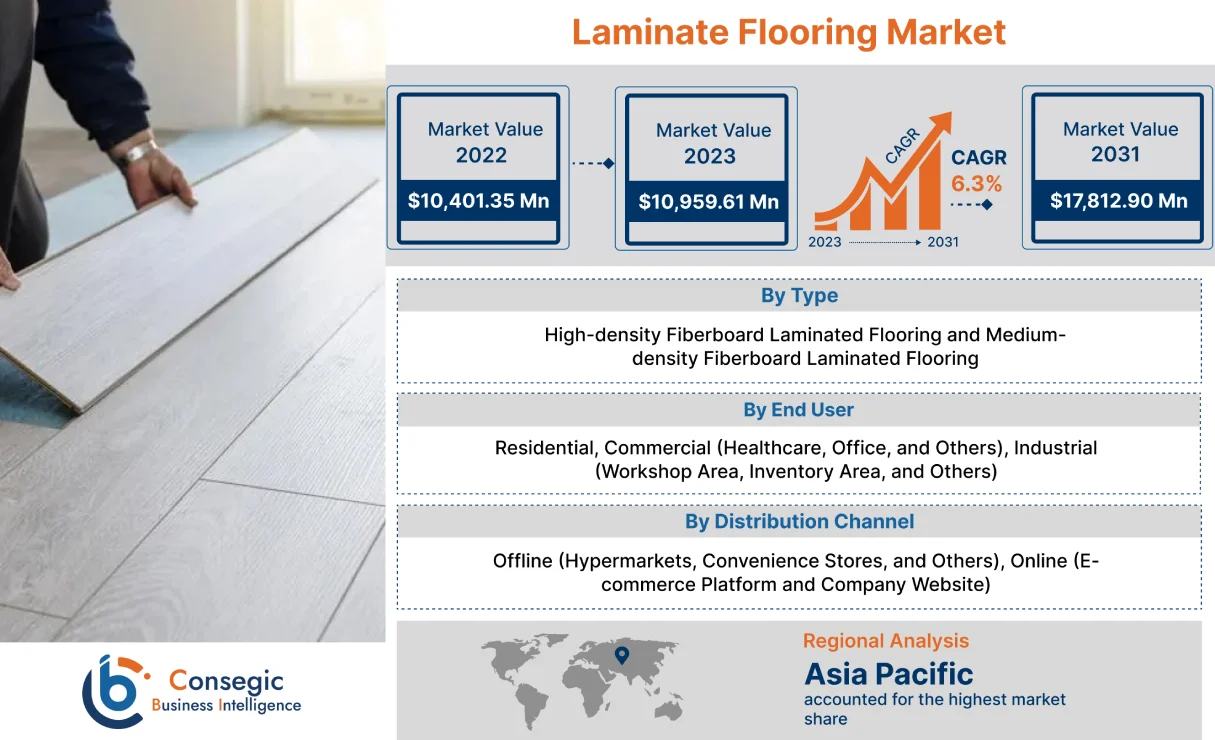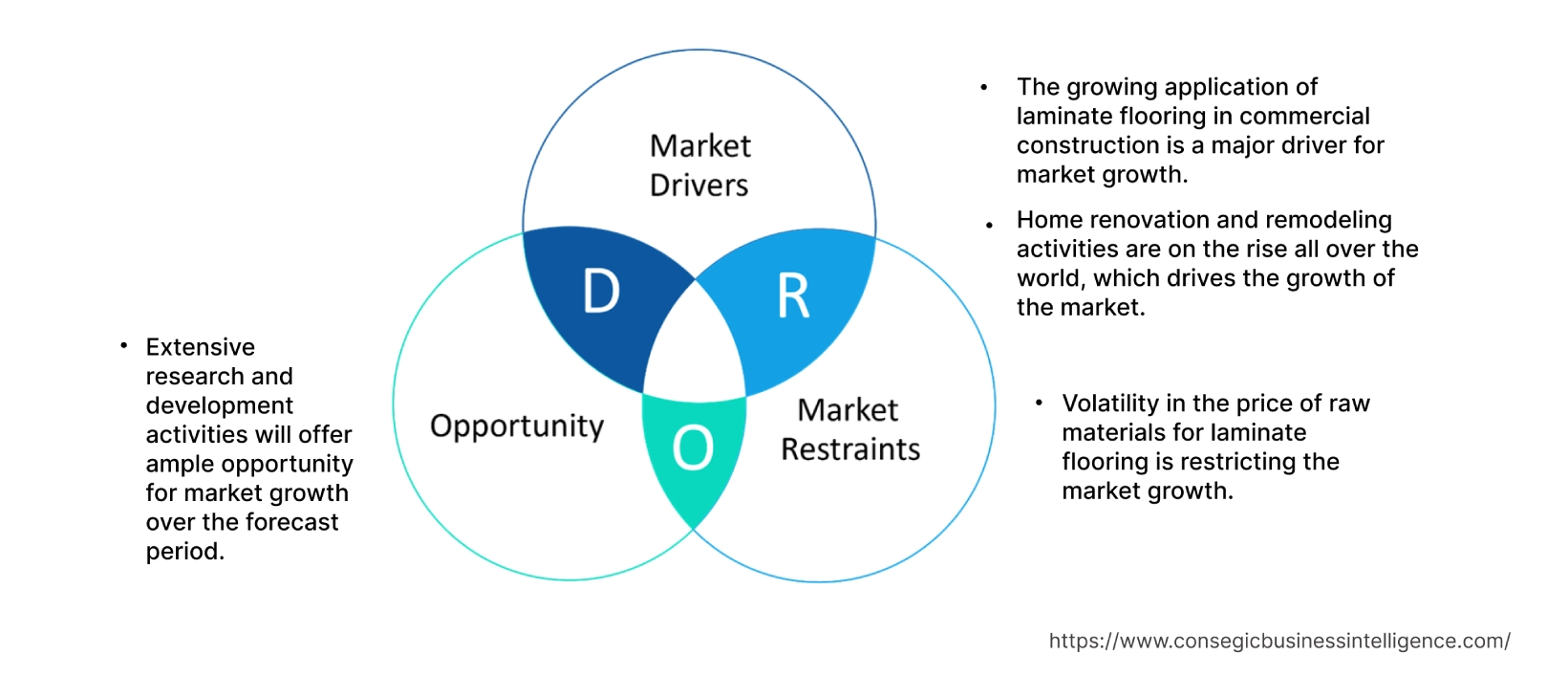- Summary
- Table Of Content
- Methodology
Laminate Flooring Market Size :
Consegic Business Intelligence analyzes that the laminate flooring market size is growing with a CAGR of 6.3% during the forecast period (2023-2031), and the market is projected to be valued at USD 17,812.90 Million by 2031 and USD 10,959.61 Million in 2023 from USD 10,401.35 Million in 2022.
Laminate Flooring Market Scope & Overview:
Laminate flooring is a type of man-made flooring that is made up of several layers of materials. The top layer is a clear, durable plastic layer that protects the floor from scratches and stains. The middle layer is a decorative layer that can be made to look like a variety of different materials, such as wood, stone, or tile. The bottom layer is a backing layer that helps to stabilize the floor and prevent it from warping. It is a popular choice for many application scopes of residential, commercial, and industrial because it is durable, affordable, and easy to install. It is also relatively low-maintenance, as it can be cleaned with a damp mop and mild detergent.
Laminate Flooring Market Insights :
Key Drivers :
The growing application in commercial construction is a major driver for the laminate flooring market.
Laminate flooring is widely used in the construction of commercial spaces, including retail stores, offices, restaurants, and hotels, due to its durability, cost-effectiveness, excellent resistance to scratches, and low maintenance requirements. Additionally, the increasing demand in healthcare facilities and educational institutes is fueled by laminate flooring's ability to withstand high foot traffic, making it an ideal choice for high-use environments. According to research by Floor Covering News, commercial flooring sales saw a notable rebound, increasing by 13.1% from 2021 to 2022. This growth is attributed to the rising preference for laminate flooring in commercial construction projects. The combination of affordability, functionality, and aesthetic appeal continues to drive the market, positioning laminate flooring as a top choice for commercial applications.
Home renovation and remodeling activities are on the rise all over the world, which drives the market.
Laminate flooring is a popular choice for these projects due to its durability, affordability, and ease of installation. Available in a wide variety of colors, textures, and styles, laminate flooring offers versatility that appeals to homeowners looking to update their spaces. According to the U.S. Houzz & Home Study, home renovation activity reached its highest rate since 2018, with renovation expenditure rising approximately 20% in 2021 compared to the previous year, marking the highest growth in four years. The surge in residential construction, coupled with the impact of the COVID-19 pandemic, further accelerated residential remodeling revenue. As homeowners increasingly focus on improving their living spaces, the demand for laminate flooring continues to rise, making it a key driver in the market’s expansion.
Key Restraints :
Volatility in the price of raw materials is restricting the market.
The fluctuating prices of essential raw materials, along with increasing costs for transportation and labor, have become major concerns for companies in the industry. For example, companies like Mannington and Phenix have implemented price increases of 4% to 8% on laminate flooring products. Additionally, the flooring manufacturing sector has been severely impacted by the disruptions caused by the COVID-19 pandemic, which has further contributed to rising raw material prices and supply chain delays. This uncertainty in pricing and the availability of raw materials hampers the ability of manufacturers to maintain consistent pricing and production levels, ultimately affecting market demand. As a result, price volatility remains a key restraint in the growth and stability of the laminate flooring market.
Future Opportunities :
Extensive research and development activities will offer ample opportunity for the market over the forecast period.
Extensive research and development (R&D) activities are expected to create significant opportunities for growth in the laminate flooring market over the forecast period. These efforts focus on enhancing the performance, aesthetics, and sustainability of laminate products. One notable development is the use of high-definition printing technology, which allows manufacturers to produce laminate flooring with intricate patterns, vibrant colors, and realistic designs at a lower cost. This innovation is expected to expand the market by offering more design options to consumers while maintaining affordability. Additionally, the adoption of embossed-in-register technology enables manufacturers to create laminate floors with textures that closely replicate the appearance and feel of natural materials such as wood and stone. This advancement improves both the visual appeal and tactile experience of laminate flooring, thus attracting a wider range of customers. As these technological improvements continue, they will drive further demand and open new avenues in the laminate flooring market growth.
Laminate Flooring Market Report Insights :
| Report Attributes | Report Details |
| Study Timeline | 2017-2031 |
| Market Size in 2031 | USD 17,812.90 Million |
| CAGR (2023-2031) | 6.3% |
| By Type | High-density Fiberboard Laminated Flooring and Medium-density Fiberboard Laminated Flooring |
| By End User | Residential, Commercial (Healthcare, Office, and Others), Industrial (Workshop Area, Inventory Area, and Others) |
| By Distribution Channel | Offline (Hypermarkets, Convenience Stores, and Others), Online (E-commerce Platform and Company Website) |
| By Region | North America, Europe, Asia-Pacific, Latin America, and Middle East & Africa |
| Key Players | Tarkett SA, Mohawk Industries Inc., Shaw Industries Group Inc., AHF, LLC., Beaulieu International Group, Sika AG, Mannington Mills, Inc., Squarefoot, Action TESA, and BVG Industries Pvt. Ltd. |
Laminate Flooring Market Segmental Analysis :
By Type :
The type segment is bifurcated into high-density fiberboard and medium-density fiberboard. In 2022, the medium-density fiberboard laminated flooring segment accounted for the highest market share in the global laminate flooring market. Moreover, it is likely to grow at the fastest CAGR over the forecast period. Medium-density fiberboard laminates accounted for the majority stake in the market due to their cost-effectiveness and smooth as well as uniform surface, which permit for regular adhesion of laminate sheets, therefore allowing a seamless finish and increasing the visual appearance of the product. Moreover, MDF laminates provide excellent versatility in design as they can mimic the appearance of various materials, including wood grains and solid colors. Additionally, they offer good dimensional stability, which is less prone to warping or swelling owing to changes in temperature. Furthermore, the segmental trends analysis shows that the ease of installation and printability of MDF laminates permit large design flexibility and customization options, which, in turn, is facilitating their laminate flooring market trends all across the globe.
By End-User :
The application segment is categorized into residential, commercial, and industrial. In 2022, The residential industry accounted for the largest share of 68.79% in the laminate flooring market share due to the increasing construction of houses, apartments, and residential complexes. Furthermore, the extensive product implementation in home renovation and improvement activities to enhance the appearance, aesthetics, and functionality of living spaces is acting as another growth-inducing factor. Moreover, the easy accessibility of a diverse range of design options, including colors, patterns, and texture, which allow homeowners to select flooring styles that perfectly suit their personal preferences and complement their interior décor, is contributing to the laminate flooring market trends.
However, the commercial segment is expected to be the fastest-growing segment over the forecast period. Long-span timber floor solutions have demonstrated their potential to compete with concrete and steel construction for multi-story commercial buildings. Owing to the high strength-to-weight ratio of timber, operative vibration performance is a critical structural design issue for long spans. According to the Floor Covering News research, commercials represent around 26.2% of total U.S. flooring sales. Therefore, the segmental trends analysis shows that the segment will grow at the fastest CAGR over the forecast period.
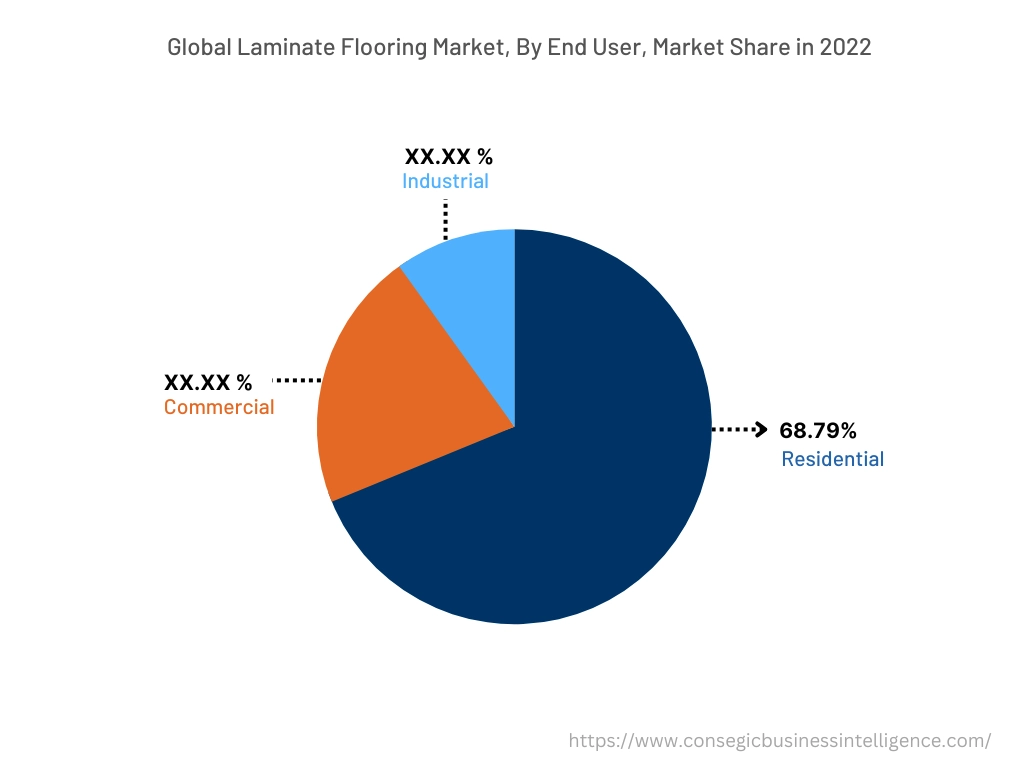
By Distribution Channel :
The distribution channel segment is categorized into offline and online. In 2022, the offline segment accounted for the highest market share in the overall laminate flooring market share. The availability of personal store assistants plays a key role in influencing customers to try out new products. These factors make hypermarkets a prime channel for companies to launch their products. New brands choose offline channels to start promoting to increase the customer base. Thus all the above-mentioned factors drive the laminate flooring market demand.
However, the online segment is expected to be the fastest-growing segment over the forecast period. The popularity of e-commerce sites and a growing number of manufacturers creating their websites are driving the development of this segment. In addition, developing urbanization trends force consumers to tend the online platforms due to ease and convenience. Apart from that online retailers are in-cashing volume sales advantages by including discounts and cash-back offers. Thus, the analysis of segmental trends shows that all these above-mentioned factors help to boost the laminate flooring market opportunities at the fastest CAGR over the forecast period.
By Region :
The regional segment includes North America, Europe, Asia Pacific, the Middle East and Africa, and Latin America.
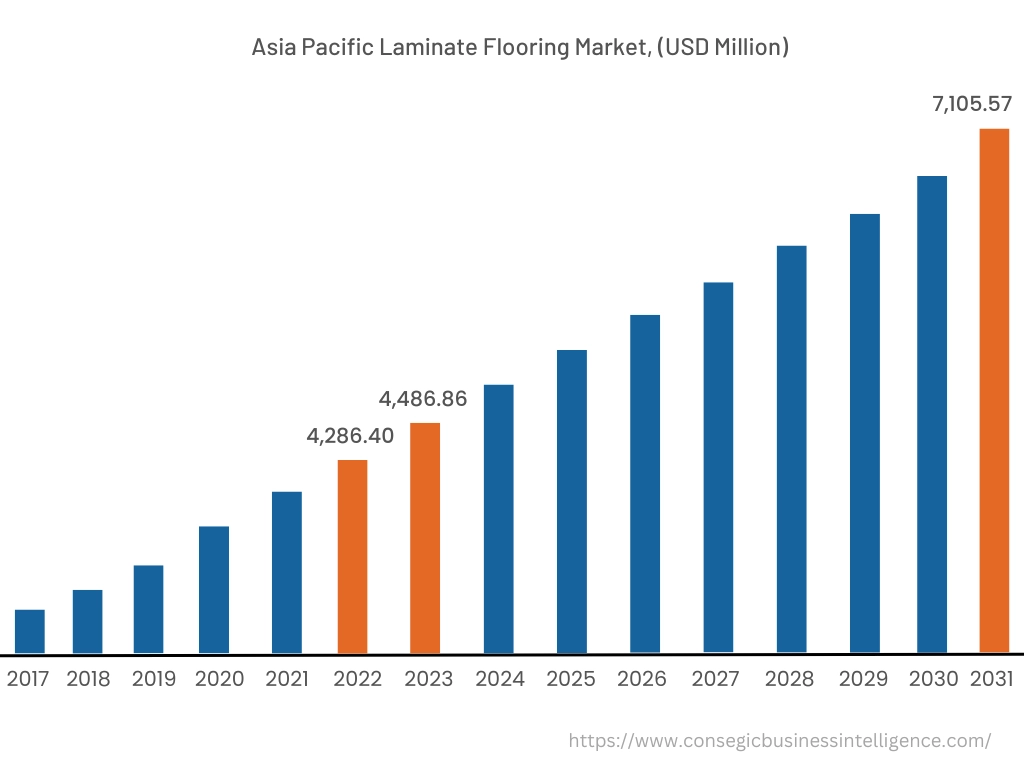
In 2022, Asia Pacific accounted for the highest market revenue at 41.21% valued at USD 4,286.40 million in 2022 and USD 4,486.86 million in 2023, it is expected to reach USD 7,105.57 million in 2031. In Asia Pacific, China accounted for the highest market share of 31.30% during the base year of 2022. In Asia Pacific China has been one of the key export sources of flooring products globally in recent decades. As per the laminate flooring market analysis, factors such as rapid development in infrastructure, changing lifestyles of consumers, and growing demand for insulation are the major factor that drives the demand for laminated flooring in the region. The presence of a large customer base, owing to the growing expenditure capacities of consumers and rapid urbanization activities in the region, is acting as another growth-inducing factor.
Moreover, the increasing investments by regional governments in infrastructural development projects, such as railway stations, airports, supermarkets, shopping malls, educational institutions, and healthcare facilities, are providing an impetus to the market. Thus, in turn, boosting the laminate flooring market expansion.
Furthermore, North America is expected to witness a significant rise over the forecast period, growing at a CAGR of 6.9% during 2023-2031. Growing demand for home decor and improving lifestyles of people are driving renovation as well as refurbishing activities in the region. For instance, Leading Indicator of Remodeling Activity (LIRA), reported that in the U.S., yearly growth of home repair and reconstruction expenditures is expected to increase investment in home furnishings such as carpets, and other floor coverings that contribute to the artistic appeal of interior spaces. Thus, as per the regional trends analysis, the region is likely to grow at the fastest CAGR over the forecast period, thus, in turn boosting the laminate flooring market expansion in the region.
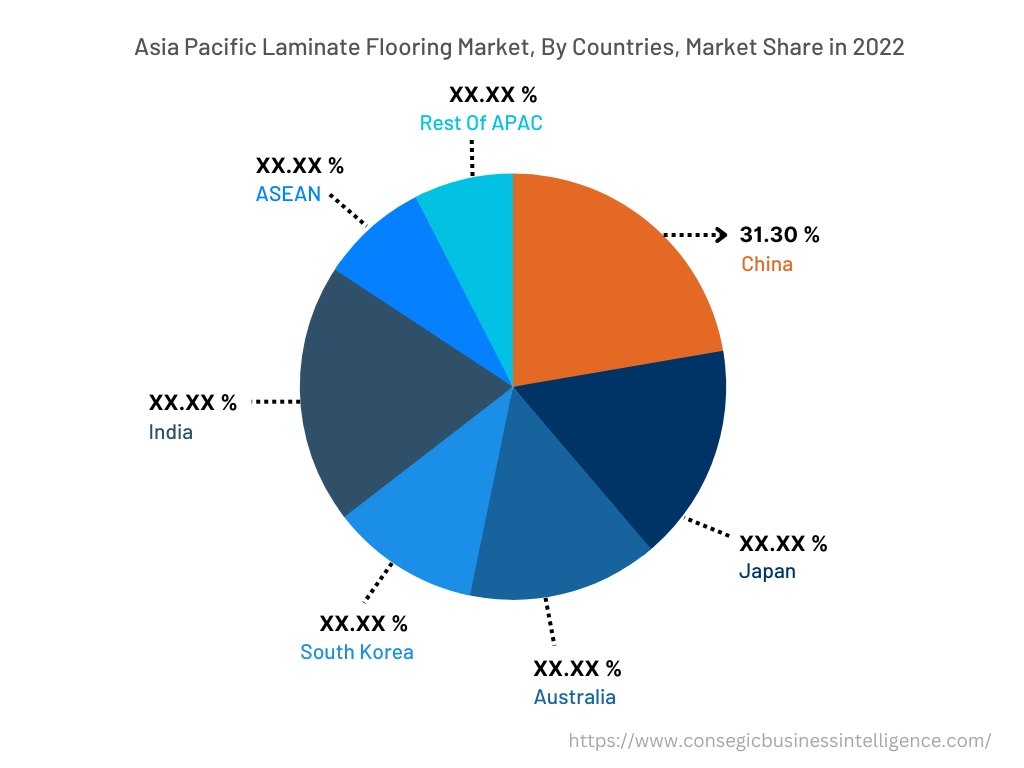
Top Key Players & Market Share Insights:
The laminate flooring market is highly competitive, with several large players and numerous small and medium-sized enterprises. These companies have strong product capabilities and a strong presence in the market through their extensive product portfolios and distribution networks. The market is characterized by intense competition, with companies focusing on expanding their product offerings and increasing their market share through mergers, acquisitions, and partnerships. The key players in the laminate flooring industry include-
- Tarkett SA
- Mohawk Industries Inc.
- Squarefoot
- Action TESA
- BVG Industries Pvt. Ltd.
- Shaw Industries Group Inc.
- AHF, LLC.
- Beaulieu International Group
- Sika AG
- Mannington Mills, Inc.
Recent Industry Developments :
- In May 2023, Armstrong World Industries, Inc. announced a new partnership with Spacekit. This partnership will allow Spacekit to offer its innovative modular, acoustical wall art on Armstrong's direct-to-customer (DTC) digital sales platform, KanopibyArmstrong.com.
- In January 2022, Notion-headquartered in India, launched the laminate flooring series, which includes the Suite, Loft, Basal, and Studio series. The products are designed for commercial as well as residential-based applications.
Key Questions Answered in the Report
What was the market size of the laminate flooring industry in 2022? +
In 2022, the market size of laminate flooring was USD 10,401.35 million.
What will be the potential market valuation for the laminate flooring industry by 2031? +
In 2031, the market size of laminate flooring will be expected to reach USD 17,812.90 million.
What are the key factors driving the growth of the laminate flooring market? +
The growing application of laminated flooring in commercial construction is a major driver for market growth.
What is the dominating segment in the laminate flooring market by the application? +
In 2022, residential accounted for the highest market share of 68.79% in the overall laminate flooring market.
Based on current market trends and future predictions, which geographical region is the dominating region in the laminate flooring market? +
Asia Pacific accounted for the highest market share in the overall laminate flooring market.
